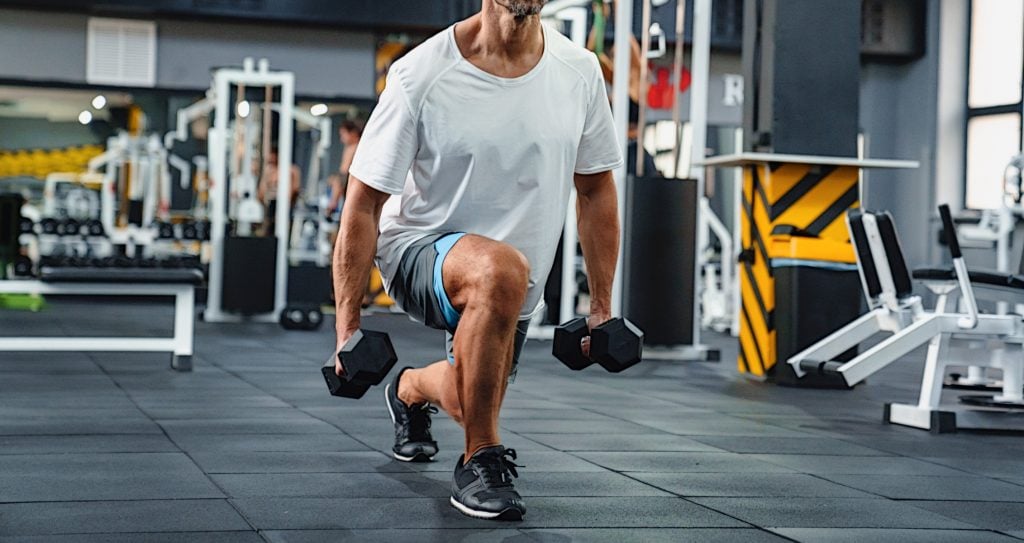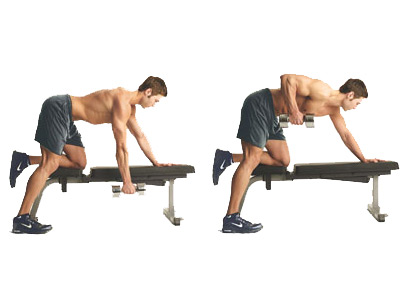Unilateral leg movements will take your athletic potential to new heights. Bilateral leg movements such as squats come with their benefits, but single-leg movements have their buffet of benefits that you just can’t get from using both legs at the same time to lift the weight you’re using.
For starters, single-leg movements take away your balance, and you’ll have to rely a lot more on your hip, knee, and core stability to control the weight you’re lifting. This is something most athletes rely on.
To learn all the benefits of training your legs unilaterally, finish the rest of this article.
What is Unilateral Training?
Unilateral training is when you train one side of your body as opposed to both sides. For example, instead of doing barbell bench press, you would do single-arm dumbbell bench press. This isolates one side of your body for you to place more focus on it without having to rely on your other side.
Unilateral Training vs. Bilateral Training
Bilateral training is when you’re using both sides of your body to lift the weight, e.g. barbell bench press. It’s great for building brute strength since you’ll be able to lift the heaviest weight possible for each muscle group using both sides of your body as opposed to just one. If you’re trying to hit a new personal record (PR) or grow the most muscle mass possible, you’ll mainly want to stick to bilateral movements. The big three exercises — barbell squat, barbell deadlift, and barbell bench press — are all bilateral movements that target the largest muscles in your body.
However, having muscular imbalances or relying too heavily on your “strong” side can cause muscular imbalances that lead to injuries or prevent you from using the heaviest weight you’re capable of using since your weak side is holding you back. And as the adage goes, you’re only as strong as your weakest link.
Honing in on just one side of your body can help you have a better mind-to-muscle connection to the muscle you’re targeting since your muscle neurons and mind is channeling all their energy to one side of your muscle instead of both. So that when you do go back to doing bilateral movements, your muscles will be more balanced and stronger. This means that you can hit new PRs on compound movements like barbell squats, barbell bent-over row, and barbell bench press.
Unilateral Leg Movements Benefits

Below, we’ll dial in on benefits that you can receive from single-leg movements.
Corrects Muscular Imbalances
Since most people typically rely heavily more on one side of their body to lift weight compared to the other, incorporating unilateral leg movements into your plan can fix any lower body muscular imbalances you may have. That’s because you’ll be forced to get your weaker side up to scale to the stronger side and won’t be able to rely on any help from the side of your body that was helping you compensate for your weak side. Of course, this will make you stronger since your weaker side won’t be holding you back anymore. This means more personal records (PRs) if you’ve been stuck at the same weight for a while!
In fact, the Journal of Science and Medicine in Sport found that strength differences between limbs can be as high as 25%. (1)
Furthermore, since you’ll be able to give your fullest attention to just one leg, your quadriceps and hamstrings will grow stronger on each leg, preventing them from being imbalanced, which will reduce your chances of hamstring strains.
Builds a Stronger Core and Improves Your Balance
Single-leg exercises are great for strengthening your core. That’s because having to rely on one leg to perform an exercise will greatly challenge your stability and balance. Your core will have to fight to stabilize your body to maintain your balance. (2)
A study found that your balance increases better with single-leg exercises compared to bilateral exercises. (3)
More Hip and Knee Stability
Similarly, unilateral movements displace the center of your knee and hip stability, which means you’ll need to stabilize them to keep your balance. This especially comes in handy for many sports. For instance, a point guard depends a lot on the stability of their hips and knees to maneuver around the court to get past defenders and drive to the basket.
Makes You More Explosive
If you’re trying to increase your vertical, then you’ll want to start doing single-leg movements for sure. That’s because unilateral movements increase your force and rate production, meaning a stronger and faster lift; therefore, you’ll have more power. (4)
For one, in sports oftentimes you’ll need the ability to jump high off the ground from just the use of one leg, so doing some sport-specific unilateral leg exercises will prep you for any situation on the field or court. Moreover, strengthening one leg at a time will correct any imbalances in your weaker leg, which will inevitably allow you to jump higher off both legs.
This 2018 study found unilateral squats more effective than bilateral squats for building strength. (5)
How to Program Unilateral Leg Workouts
When programming unilateral leg workouts, you’ll want to keep your goal in mind. If your goal is hypertrophy (larger muscles), then you’ll want to do eight to 10 reps per side and focus on movements that target your quadriceps and hamstrings separately, such as single-leg machine leg extension and single leg machine leg curl. However, if your goal is to increase your power, vertical, and athletic ability, then you’ll want to use heavy weight and keep the reps below five reps per leg and do movements that challenge your knee, hip, and core stability the most and stick with movements such as dumbbell Bulgarian split squats.
Example Workout
- Pistol squats (weights optional) 3 sets x 5-8 reps
- Dumbbell split squat 3 sets x 5-8 reps
- Single-leg dumbbell deadlift 2 sets x 8-10 reps
- Forward lunge 2 sets x 12 reps
- Lateral lunge 2 sets x 10 reps
Conclusion
Unilateral leg movements are essential for athletes and will increase your balance, stability, and power. You’ll have to rely on your ability to lift weight with just the use of one of your legs; this challenges your hip, knee, and core stability much more than bilateral movements. Plus, your proprioception is tested exponentially more with single-leg movements.
Have you ever tried unilateral training before? If so, what benefits did you noticed compared to bilateral movements? Tell us below in the comment section.
Reference
1 – A. Pearce, D. Kidgell, Reduction of the bilateral deficit following unilateral strength training: A TMS study, Journal of Science and Medicine in Sport, Volume 13, Supplement 1, 2010, Page e88.
2 – Saeterbakken, Atle & Fimland, Marius. (2011). Muscle activity of the core during bilateral, unilateral, seated and standing resistance exercise. European journal of applied physiology. 112. 1671-8. 10.1007/s00421-011-2141-7.
3 – Fuad A. Hazime, Paul Allard, Maiza Ritomy Ide, Cassio Marinho Siqueira, César Ferreira Amorim, Clarice Tanaka,Postural control under visual and proprioceptive perturbations during double and single limb stances: Insights for balance training, Journal of Bodywork and Movement Therapies, Volume 16, Issue 2, 2012, Pages 224-229.
4- Adamson, M., MacQuaide, N., Helgerud, J. et al. Unilateral arm strength training improves contralateral peak force and rate of force development. Eur J Appl Physiol 103, 553–559 (2008).
5 – Eliassen, W., Saeterbakken, A. H., & van den Tillaar, R. (2018). COMPARISON OF BILATERAL AND UNILATERAL SQUAT EXERCISES ON BARBELL KINEMATICS AND MUSCLE ACTIVATION. International journal of sports physical therapy, 13(5), 871–881.

